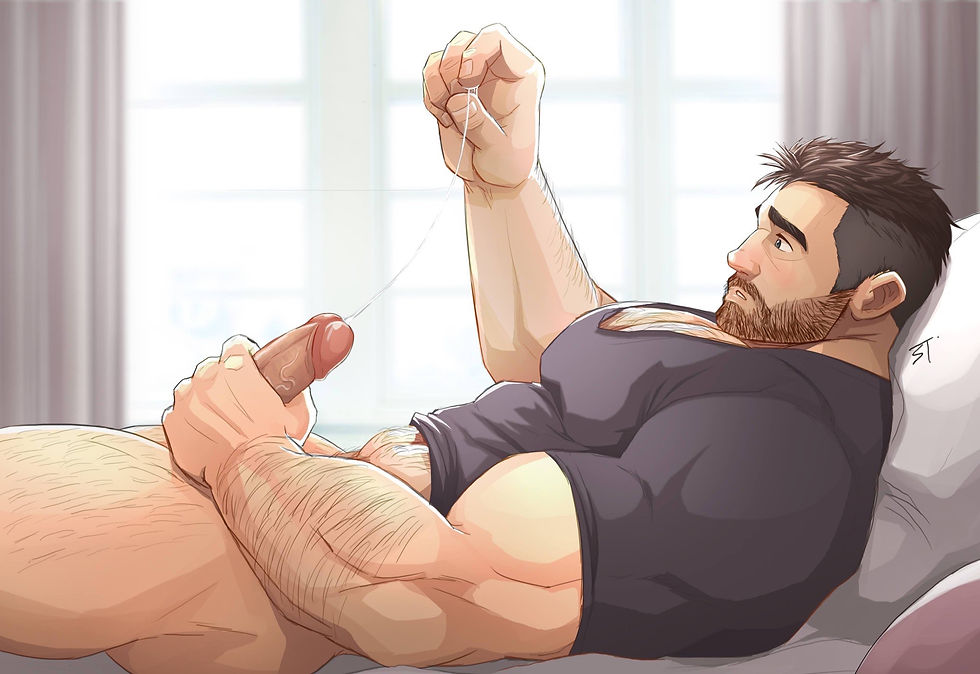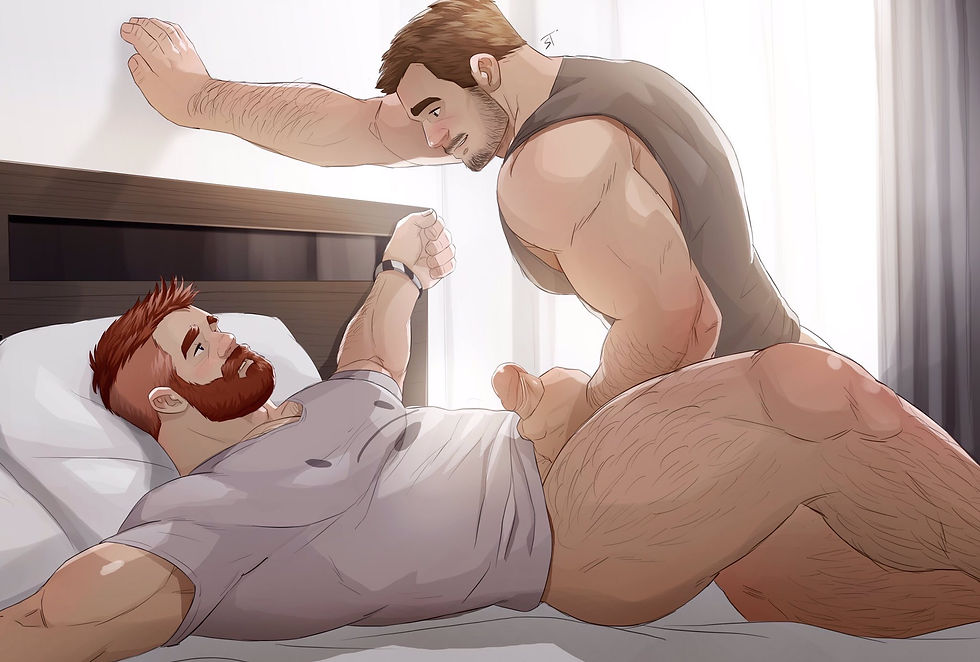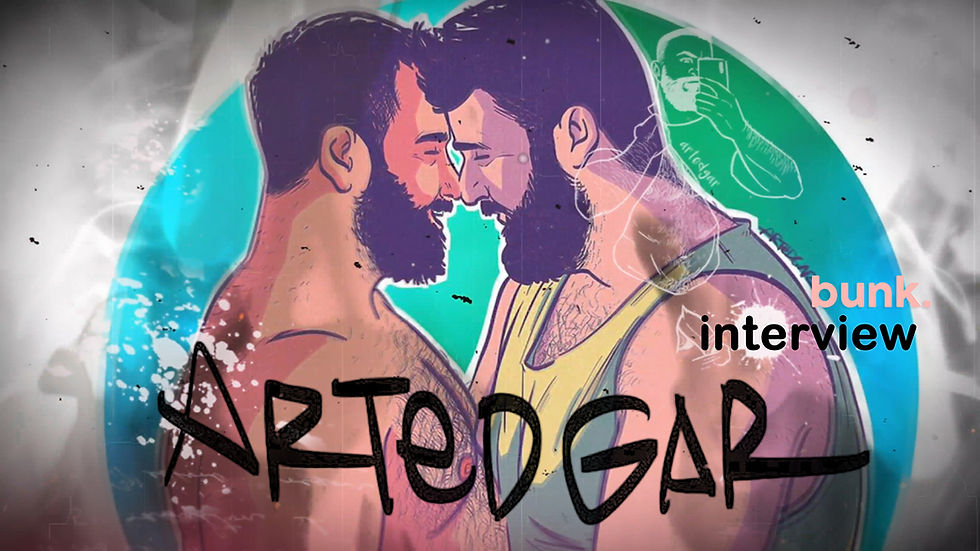'Men with big beards and sadness in their eyes' - Art by JoJi
- bunk.

- Nov 3, 2019
- 6 min read
Updated: Jun 22, 2021

JoJi is a homoerotic artist who draws beautiful, hairy, muscular men - men with big eyes and big hearts. They are drawn out of love and are shared for the pleasure of others all over the world.
The charm of these works is how JoJi uses subtle storytelling to make these men endearing, sexy and familiar - like a friend. Looking through the catalogue of his artworks, we find his men engaging with life and one another. We see them cuddling in a lover’s embrace, playing and fooling around with one another, or alone looking sorrowfully into the distance. These men aren’t just there solely for the viewers sexual gratification, they appear genuine. While there is nudity and explicit sex in some of the images, they speak more so about JoJi‘a thoughts and feelings. Such as how it feels to be gay, how it feels to be in or out of love and build idyllic images of companionship and love. They are a love letter to men everywhere.
'Many of the pictures I draw are inspired by my feelings, everything from music I listen to, people I see around everyday. I will think of a short story involving all of these things, interpret it and then research inspiration images from the internet and then start to draw it out'

JoJi was born and lives in Thailand and producing these indie artworks is his full time work, sometimes working on his artworks up to 5 days a week.
Having no previous art school training or classes in creative practice, his skills are all self-taught and explored. Even now, he explains how he still learns from new techniques from online videos and also from taking on board constructive comments from online fans and the community.
It’s this community of indie artists, fans and followers that engage, share and support this type of work. It’s a movement that has grown up and evolved alongside the internet, and it has enabled people to discover and share art and media they may not have been able to buy anywhere, or may not have an audience to share with.
This is the type of artwork that you (decades ago) may have only found in the back pages of an underground magazine, or accidentally came across in an event or through a friend. Now it’s far easier to become a keen digester of these images. It’s now in an arena of active exchange and celebration, where social media and blogging platforms become our digest of all new creative works. Online services such as Patreon or Gumroad exist to support all kinds of artists and illustrators to who are creating specialist independent works.
Independent homoerotic art now has its own gallery space, and it’s one that is navigated and curated by the community, the fans, and the artists that create it all.
Having drawn since he was very young, drawing cartoons and keeping them in notebooks, it wasn't until he was about 15 that he became curious about drawing the male body. Then at around age 20 JoJi discovered a type of artwork online that he felt passionate about, it is known online as 'Bara art'.
Here JoJi is referring to a type of male homoerotic art that typically depicts big, burly, hairy, muscled men who's masculinity is sometimes exaggerated and always sexualised. It’s now how his work is categorised.

The term Bara has a history both inside and outside Japan, it’s origin was from Japanese 'Bara manga', and this type of manga typically depicted sometimes aggressively explicit sex, between very masculine men. The way this work was digested outside of Japan largely happened online, where fans would produce bootleg 'scanlations' of the work, allowing it to reach new audiences. Even without translations, many could follow the story simply through spending time with the, sexually explicit, images of men. Understanding the story without the need for words. Much like JoJi says he likes his work to.
Any artwork of bear-like, muscular, burly men therefore started to be described as Bara stemming from the association with the characters in this genre of manga.
The word 'bara' in Japanese translates as 'rose' and colloquially it is meant as a gay slur, perhaps similar to how ‘pansy’ would be in the UK to describe an effeminate male.
Bara draws its name from the popular 1970s gay magazine Barazoku 薔薇族 or 'Rose Tribe', the magazine was radical, challenging and posited a more positive empowering identity for homosexual men at the time, it helped Japanese gay men feel less isolated from society and their families. It was filled with erotica, essays and a sense of empowerment for men who are attracted to other men in Japan. Although homosexuality was not against the law, it still encountered some prejudice and the appearance of Barazoku aimed to become a vehicle to console this. It's presence in gay bars, cafes, cruising bars and porn cinemas allowed it to be prominent appear culturally prominent for gay men, and was possibly how gay comics and illustrations grew to be referred to at a time as 'Bara'

However, many Japanese artists do not use this term any longer to describe the genre, as once it was a reclaiming of a word, it has now culturally changed and not used by the community. This genre has gone on to simply be called 'Gei Komi' by Gengoroh Tagame or or as suggested by Graham Kolbeins of massive; ‘Gay Manga’.
Bara is a word or a category of art, that despite its lack of a political correctness (or perhaps taste) in the world of Japanese manga genres, is still embraced by creatives and fans to distinguish a type of homoerotic content in other parts of the world. When you look for bara as an art type, you are generally looking to find manly, hairy, big, muscled, chubby, daddies or older brothers - or even beastly animals or furries.

Unlike the sexual plots and explicit drawings you find in some Gay Manga (such as in the works of Gengoroh Tagame above) JoJi’s expression leads with feelings and his men are always drawn in a thoughtful, loving and sentimental way. This in my mind is the shining emblem that illustrates the beauty of all the characters he draws.
His men appear sensitive, warm and friendly and they’re more engaged in life and love. Even when they’re nude or having sex, they aren’t oozing with an aggressive masculinity, or a domineering sexuality - it doesn’t feel purely pornographic. These men are created to be beautiful objects but also for the viewer to believe in. They are building an idyllic world for gay companionship and relationships. And showing all aspects of male on male lobe. JoJi says:
'When I walk and I see a gay couple walking hand in hand, they show love as everybody else. It is beautiful.'

When I asked JoJi about the narratives within his work, he added playfully ‘I like to draw men with big beards and sadness in their eyes’. And while he laughed while saying this, this is definitely an accurate description. There are a lot of men who look like they are pondering, pensive - maybe they have experienced a loss in love? They’re wide eyed, raised eyebrows and searching for a connection. And yes, they pretty much always have a beard!
'My character drawing has improved and grown in the past few years, if you look through my history you will see that they have developed. And also in their honesty and the dream they portray'
JoJi’s men all have a definite style, from the shape of the eyes to the type of body and body hair. More so than this, it’s how and why he draws them that make his images so unique. They are often hyper-masculine, with bulging muscles and penises - but almost always with bulging hearts and eyes. These qualities balance his art and work together to make his characters shine from his imagination into the minds and the desire of the viewer. The love of these men will change from person to person - whether we to be like them, want to hold them, laugh with them, or want to fuck them. They are celebrated and touch a wide range of male fans all over the world!
‘I am grateful for the love from my family, friends and fans - I must thank them very much. I would not be where I am today without them supporting me, encouraging me and listening when I have a problem. I love them very much.’

JoJi's work can be found on Facebook, Instagram and Twitter. You can support his work at Patreon, where you will receive added bonuses and perks as a patron. Or buy digital art at Gumroad.
JoJi also has a fantastic poster book available to buy, where each page can be removed to use as wallart Buy your copy here.
If you'd like to buy prints, phone cases and other products, be sure to see visit his RedBubble
References
Mackintosh. J. D - Itō Bungaku and the Solidarity of the Rose Tribes [Barazoku] http://intersections.anu.edu.au/issue12/aoki.html#n25
https://gaymanga.tumblr.com/post/102108686772/i-see-that-the-wish-to-move-away-from-the-term


















































Comments